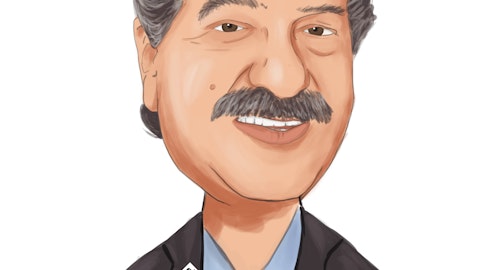BankUnited, Inc. (NYSE:BKU) Q3 2023 Earnings Call Transcript October 19, 2023
BankUnited, Inc. misses on earnings expectations. Reported EPS is $0.63 EPS, expectations were $0.71.
Operator: Good day. Thank you for standing by. Welcome to the BankUnited Third Quarter 2023 Earnings Conference Call. At this time, all participants are in a listen-only mode. After the speaker’s presentation, there will be a question-and-answer session. [Operator Instructions] Please be advised today’s conference is being recorded. I would now like to hand the conference over to your speaker today, Susan Greenfield, Corporate Secretary. Please go ahead.
Susan Greenfield: Thank you, Michelle. Good morning, and thank you for joining us today on our third quarter 2023 results conference call. On the call this morning are Raj Singh, our Chairman, President and CEO; and Leslie Lunak, our Chief Financial Officer; and Tom Cornish, our Chief Operating Officer. Before we start, I’d like to remind everyone that this call may contain forward-looking statements within the meaning of the Private Securities Litigation Reform Act of 1995, that reflect the company’s current views with respect to, among other things, future events and financial performance. Any forward-looking statements made during this call are based on the historical performance of the company and its subsidiaries or on the company’s current plans, estimates and expectations.
The inclusion of this forward-looking information should not be regarded as a representation by the company that the future plans, estimates or expectations contemplated by the company will be achieved. Such forward-looking statements are subject to various risks and uncertainties and assumptions, including, without limitation, those relating to the company’s operations, financial results, financial condition, business prospects, growth strategy and liquidity, including as impacted by external circumstances outside the company’s direct control such as adverse events impacting the financial services industry. The company does not undertake any obligation to publicly update or review any forward-looking statements, whether as a result of new information, future developments or otherwise.
A number of important factors could cause actual results to differ materially from those indicated by the forward-looking statements. These factors should not be concerned as exhaustive. Information on these factors can be found in the company’s annual report on Form 10-K for the year ended December 31, 2022, and any subsequent quarterly report on Form 10-Q or current report on Form 8-K, which are available at the SEC’s website, www.sec.gov. With that, I’d like to turn the call over to Raj.
Raj Singh: Thank you, Susan. Welcome, everyone. Thank you for joining us for our earnings call. In preparation for this call, I usually ask Leslie, like a week before if she can kind of guide me as to what are the things investors are looking for? What are the hot topics, so this time I did the same thing. And what Leslie forwarded me was an e-mail from one of the sell-side analysts, I think it might have been JPMorgan, with basically saying — not specifically to us, but generally bank investors are looking for like five or six things that are top of mind. So in my comments, I’m going to go straight to those few things and try and answer them. The things were in that order, NIM inflation, deposit stability, both pricing inflows, credit trends, unrealized losses, expense management.
And the last bullet point was sort of regulatory (this really applies to larger banks). So I’m going to try and get straight to that, rather than reverse state, what’s in our earnings. It’s been out for a couple of hours, you probably have read where the numbers came out. But those are the big topics, let’s just talk about them directly. NIM, our NIM increased by 9 basis points from 2.47% to 2.56%. Just for context, if you go back last quarter, we told you that, while our NIM had gone down from first quarter to second quarter. Second quarter was pretty flat every month was 2.47%. This quarter, we went up. So if you go back from January and look to now, Jan to Feb, Feb to March, March or April, NIM was declining. And then for the next three months, it was flat.
And now for the 3 months after that, it’s gone up. So it’s created a nice curve that I like, and I think we can safely predict that this modest improvement will keep happening in the next few months. Deposit stability is the next question. Again, this quarter, we grew outside of brokered. We grew about $500 million in deposits and even grew noninterest DDA by a little more than $50 million. Our NIDDA to total deposits is stable at about 28%. I’ve been asked this question many, many times over the course of the last two or three years, like what do you think the long-term run rate sort of that ratio is? Where will you stabilize in terms of DDA percentage? And I’ve never been able to answer that question, because to be very honest, I don’t know what — when all is said and done, where things will stabilize.
But now looking at this data, not just for this quarter, but for the last several months, I’m beginning to get confident in saying that, I think we’re there or close to being there. So, you know, and if we get another quarter or two of this, which I think we will be able to declare that this seems to be the bottoming on that ratio as well. And there, we say that we should to actually improve from there and try and get above 30% again over the course of the next few quarters. Credit trends, quickly, net charge-offs, again, very low at 7 basis points. I think last quarter, they were maybe 8 basis points, I remember, right? NPAs are at 40 basis points. If you carve out the SBA guarantee portion, that’s about 11 basis points of that 40. So still pretty low.
They were slightly lower than that last quarter, but they’re about kind of bouncing out in that region. Unrealized losses came in at 407 that of AOCI is about 407, I think. And last quarter, it was a little bit better at 373, I think. Now obviously, that’s a function of what’s happened to rates, especially in the last few weeks. Expenses, I think we guided to you that for the second-half of the year, we’re going to try and keep expenses flat, and I think we pretty much delivered on that. Let me add a few other things which are not. On the regulatory front, like I said, that e-mail said, it’s really a question for larger banks, but I don’t really have anything special to report on the regulatory front that you already haven’t read in the American Banker.
The rest of the balance sheet quickly just to go over that. securities were down $257 million. Loans, like we said to you, we’re taking Resi down because we’ve gotten overweighted in Resi that was down to 25%. C&I was up 100%, CRE was up 46%. Overall, deposit loans came in down to 74%. I will make a point that even within CRE, while C&I growth of $100 million, we actually did push out about $300 million roughly of non-core C&I. So if we have not done that, it would have been much higher. We feel like we’re getting done with what we need to push out in terms of transactional business. So feeling pretty good looking forward. FHLB, we paid off a little over $800 million. Brokered CDs we paid off a little over $200 million. Actually, FHLB balances now stand lower than they were at the end of last year.
So from a balance sheet perspective, we feel pretty good loan-to-deposit ratio has gone down to 93% from 95% last quarter. And despite taking the balance sheet down as much as we have, our PPNR was slightly up. So I’m feeling pretty good about the way the quarter turned out. We did built reserves this quarter. ACL was up quite meaningfully to 80 basis points. And that’s because, we don’t know when a slowdown is coming, if it’s in a quarter or two or three, but it does seem like something will happen. The Fed has done a lot to slow the economy down. And hopefully, it’s just a soft landing, but it may be a mild recession, and we have to be ready for it. So we did build reserves up. Most of that reserve built was really because of the Moody’s outlook got worse.
And when you run it through our numbers, that contributed to more than half of our provision. A quick comment on the environment. I always make a statement or two on this. I think on the rate side, rate economy and regulatory, I’ll talk about all three. On the rate side, my personal opinion is, I think the Fed is done. Whatever a little more they wanted to do, I think the market is doing for them. And I would be surprised if there is much movement from the Fed. Maybe another move in a couple of meetings, but it feels like that story has inflected. The economy is still coming along fine. But reading more and more about how the consumer is pretty much done depleting the buildup of cash from the pandemic. So we’re being very careful and vigilant on the economy to see any signs of cracking.
I think eventually, we will see some. And on the regulatory front, a lot that is about to happen that we’re all reading about. It impacts obviously banks in the $100 million to trillion range a lot more. There will be some trickle-down effect for us. So, but on a day-to-day basis, I think everything is fine in the regulatory front. I don’t think anybody is being unreasonable. And yes, there will be a little more burden on the regulatory front that we all have to deal with. But I think it’s sometimes a little overplayed. So with that, I’m missing anything. No, I just wrote these things down on a piece of paper. So I’ll jump in and interrupt Tom and Leslie as they are talking through their stuff. But once again, thank you for joining us. I’ll turn this over to Tom.
Tom Cornish: Great. Thank you, Raj. A little bit more follow-up on the discussion on deposits, and I’ll link it a bit with our dialogue last quarter. We talked about having a good level of confidence in a strong deposit pipeline. We saw that come to fruition in this quarter with the operating lines of business delivering, as Raj said, almost $500 million of deposit growth. That was really across all of our operating businesses. So it was great to see that, $484 million was the exact number, as we look at this quarter and think about what our deposit pipeline looks like, it continues to be significant and kind of in line with what we saw last quarter in executing the strategy of Core operating accounts, NIDDA business, treasury management business and so forth.
So our pipeline overall is not diminished from what it was last quarter, despite bringing on $484 million of new deposits during Q3. So we feel good about that. There’s some information in the deck on Slide 8, our largest deposit vertical continues to be the title solutions business with deposits of about $2.8 billion, as of September 30. And there’s no other real significant concentration within the deposit book. Talk a little bit more about the loan side. Consistent with the strategy we’ve outlined for you, Resi declined by $225 million. CRE was up about $46 million for the quarter. The overall outlook for CRE is a little bit more challenging in the market today. We’re not seeing as strong of pipeline opportunities at today’s interest rate level and cap rate level.

A woman signing a mortgage loan in a modern banking hall. Editorial photo for a financial news article. 8k. –ar 16:9
Less deals are making sense. So we did get $46 million in growth, and that asset category. Loan category has been relatively flat all year. If you look at where we started off the year, and market conditions remain challenging. We’re happy with our overall portfolio that we have. The new generation right now is not easy. As Raj said, C&I was up $101 million for the quarter. That number really was a lot better, absent the push out of nonstrategic relationships that Raj talked about. We had an opportunity to exit in commitments about $650 million of commitments for the quarter. Which was just slightly less than $300 million in UPB. All of these were relationships that were not core to our go-forward strategy. And generally, they did not either meet the pricing opportunities that we see in the existing market today or any deposit strategy that we’re moving forward with.
So we took the opportunity to exit those in the quarter. If we look at kind of quarter-quarter, I guess, would be the best way I would say it. We had actually a terrific quarter in small business lending. We had a terrific quarter in the commercial segment. All of those credits that we talked about are in the corporate banking segment. And even that grew after walking away from $650 million of commitments. So I think as Raj said, we’re — while there will be other things like that, that will come up and redial the deals that will come up, that’s probably the largest amount we’re going to see in the quarter. So we’re — pipelines in that segment remain very strong. Across all of our geographic markets and across all of our industry segments.
So we feel pretty good about the C&I business as a whole across all segments. The franchise equipment, municipal finance business continued to trend down modestly and mortgage warehouse lending was down $116 million in response to what’s happening in the residential mortgage market as a whole. Average rate on new production for the quarter was between 8% and 8.5% for C&I segment. We’re seeing generally deal opportunities kind of in the SOFR plus 30%, kind of, range. So that’s part of what’s happening in this trade-off of opportunities where we have the ability to exit credits that are significantly less than that in yield and reinvest it in more relationship-oriented transactions, where we’re currently seeing better yields. For the CRE pipeline, what we’re seeing is yields kind of just slightly under the 8% level.
I spend a little bit of time, a little bit more on the CRE portfolio, you’ve got significant detail on slides 12 through 14, in the supplemental deck, but a few overall comments. Our CRE portfolio continues to be modest to the overall bank’s balance sheet at 23.5% of loans or accretive risk based — total risk-based capital is 168%. Which is well below the regulatory guidance threshold. To-date, any potential concerns that we have in any loans. We’re not really broad across any asset category, they’re very specific to a particular loan or a particular submarket. As of September 30, the weighted average LTV of the CRE portfolio was 56%, the weighted average debt service coverage ratio was 1.8, and about 15% of the CRE portfolio matures in the next 12 months.
About 8% both matures in the next 12 months and is fixed rate. So our maturity schedule over the next 12 months is relatively light. Specifically to the office sector, and we feel good about office overall, the portfolio that we have, in particular, it’s $1.8 billion, of that $1.8 billion, about $200 million is in traditional medical office facility. So that’s kind of different than the than the standard office portfolio that everyone looks at. But the total is about $1.8 million with $200 million in medical office. The weighted average LTV of the office portfolio was 64% and weighted average debt service coverage ratio was 1.7 as of September 30. And you have detail in there, giving you a breakdown geography-wise, asset class wise. But as of 9/30 95% was pass-rated.
58% of the office portfolio is in Florida. Virtually all of that is suburban office. The Florida market in all major metropolitan areas continues to perform very well. So we feel pretty good about where we are from a Florida perspective. There are some other slides on 14 to give you some breakdown between Florida and the New York market. With respect to the New York state portfolio, 44% of that portfolio is in Manhattan. It’s a little under $200 million of office exposure in Manhattan. Our properties currently are 95% leased. And we only have a 5% rollover in the next 12 months. Overall, the office portfolio has an 11% rollover in the next 12 months. When we look at sort of credit quality within the overall pre portfolio. If you look at 12/31 ’22, we had $91 million that were rated below past.
This quarter, we had $90 million. So the credit trends have been very stable. In this portfolio, and we’re watching it closely, but we feel very good about the overall CRE portfolio. And good about our office portfolio given the properties, geographic locations and mix between suburban and office. So with that, I’ll turn it over to Leslie.
Leslie Lunak: Great. Thanks, Tom. Just to reiterate, net income for the quarter was $47 million or $0.63 per share. And earnings this quarter were impacted by the reserve build that we took this quarter. Great news about the net interest margin up to 256 from 247 last quarter. We’re starting to see all of the balance sheet strategy that we laid out for you in the past getting some traction and having a positive impact on the NIM. Total earning asset yield increased from 530 to 552 with securities going up from 519 to 548, while the yield on loans went up from 553 to 554. Cost of deposits was up 28 basis points. This compares to a 41 basis point increase last quarter. So we’re continuing to see that trend of slowing in the rate of increase of our overall cost of deposits, that now sits at 274.
We also saw the decline in relatively higher priced wholesale funding having a positive impact on the NIM this quarter. The provision. I’m sure you’re all going to ask questions about the provision, so I’ll try to answer them before you ask them. The provision was $33 million this quarter, and the ACL to loans ratio increased from 68 basis points to 80 basis points. Even though net charge-offs remained very, very low. The biggest driver of the provision this quarter and the increase in the ACL was the impact of the Moody’s forecast in the model and a slightly less favorable economic outlook in those forecasts. The things that were really drivers of that. The biggest one was really the rate forecast, which has a little bit higher for longer rate forecast than we saw last quarter.
And there were a couple of other factors as well, but that was the most significant one. Changes in portfolio, composition, a little bit of a bump up in specific reserves and some risk rating migration also impacted the reserve. And if you look at Slide 16, you see a waterfall chart of all the different factors that impacted the reserve this quarter. Specifically, the CRE office portfolio, the reserve was up to 99 basis points compared to 83 at June 30. So a little bit of build there as well. Last quarter, we provided you some stress testing results. We repeated those in the deck this quarter, just in case you’re interested that they haven’t changed. Nothing really to say about noninterest income expense this quarter, no real material or significant trends there.
And I think Raj already mentioned that we would expect noninterest expense for Q4 to remain relatively flat again. All of our capital ratios increased this quarter. Holding company CET 1 was 11.4%. Pro forma, including AOCI, 9.8% at September 30. So very robust capital levels. And liquidity remains robust as well. There are some details on that in the slides if you’re interested. And with that, I’ll turn it back over to Raj for closing comments.
Raj Singh: I would say that I was very good and not interrupting either of you.
Leslie Lunak: You were.
Raj Singh: That’s not there out of time or two, but I did not. Let’s turn it over for Q&A.
Operator: [Operator Instructions] Our first question is going to come from the line of Will Jones with KBW. Your line is open. Please go ahead.
See also Retirement Stock Portfolio: 12 Consumer Stocks To Consider and 15 Countries that Provided the Highest Military Aid to Ukraine.
Q&A Session
Follow Bankunited Inc. (NYSE:BKU)
Follow Bankunited Inc. (NYSE:BKU)
Will Jones: Hey, great. Good morning. Thanks for the questions. What Leslie said, I wanted to ask about the reserves. You guys have — really, if you look back over the past four quarters or five, you’ve really been steadily building since the end of last year. I can appreciate that I got this quarter was really another macro-driven bill. But just wanted to confirm, there’s really not anything underlying you’re seeing in the book that justified any of this — I know classified and criticized did see a little bit, as well as maybe some NPAs, but just wanted to confirm that. And just as we think forward, I just wanted to get your sense of what the messaging is on the provision, as we look into next year. Do you really feel like the lion’s share of reserve bill is done from here and to the extent that, yes, we may be in higher for longer — higher for longer scenario, Moody’s kind of stable that the reserve would too stay stable or if there’s really a higher number in mind that the reserve needs to be at.
Raj Singh: Well, it’s not really that we’re trying to solve for a number. I actually joked with the management…
Leslie Lunak: That was true. I’s going to be a very easy answer to your question, but…
Raj Singh: Yes, it is. CECL has brought us to this place where I joke about this often that the economists at Moody’s can wake up on the wrong side of the bed and impact our P&L in any given quarter that anything else we do. So unfortunately, that is who we are wedded to. So it will depend a lot on what Moody’s puts out in three months from now. And what — how their outlook changes. That is a big driver. Now I will say this much, that if going into a recession or a slowdown, it’s painful with all these build that happen, it has the exact mirror opposite effect on the way out. So what can feel like pain can feel like gain a year down the road, but who knows. We’re not trying to solve for a number that if we can get there by a certain amount of time. That’s not what this is. This is purely based on the math that works off of Moody’s forecast, and I’m not sure how they will forecast six days to 90 days from now.
Leslie Lunak: Yes. And the other thing I would say, the other thing that is having some impact and will continue to have some impact as we see the portfolio composition shift out of residential into commercial, you will also see the reserve gradually build because the commercial portfolio does carry — and you can see in our slides, we showed you the allocation by type of loan. So you will see some gradual reserve build as that portfolio shift continues to happen as well. That’s the only other thing…
Raj Singh: But that’s going to be gradual, because the portfolio is not changing overnight, but gradually, absolutely like that will happen.
Leslie Lunak: Exactly. But there’s nothing, it’s not like, oh my gosh, we’re seeing trouble brewing in the portfolio, we better build reserves. It’s not that.
Raj Singh: Yes.
Will Jones: Got you. Got you. That’s very helpful. I know [Indiscernible] really kind of monster, but — that’s helpful, thanks. And then I wanted to turn to the margin, the margin. It was great to see and collect this quarter. It really feels like it was a story of the remix on the funding side, that’s really been partially enabled by some of this great deposit growth you’re seeing and it feels like momentum is continuing there. And Raj, you mentioned the margin was up each consecutive month of this quarter. Just curious where the margin ended the quarter, maybe what the margin was in the month of September?
Leslie Lunak: So I think I don’t think that’s what Raj said.
Raj Singh: No. I think last quarter, we did give you — get into the details of month by month. I’d rather not go into the — make this a trend.
Leslie Lunak: Month by month can be really porky, because if one weird thing happens in a month and you’re annualizing a one-month reserve. So I don’t think looking at it month-by-month is really very helpful.
Raj Singh: But we will say that fourth quarter — we think it will be — margin will be modestly up again. Unless there’s something really bizarre that happens in the quarter, based on what we’re seeing so far, it looks like the trajectory will continue. It’s not going to get to 3% in the next quarter, but it will keep improving from where it is.
Will Jones: Got you. Okay. That makes sense. And I guess just thinking a little more intermediate term, to the extent that this deposit pipeline continues to materialize, you see maybe a little less FHLB in the funding mix moving forward, and you get some asset repricing that keeps flowing through. Do you feel like the margin continues to expand like through 2024? Or do you feel like it…
Raj Singh: So I’m under strict orders from Leslie, not to talk about 2024 because we haven’t done it. The whole planning cycle. So here now with guidance Yes. We will give you guidance as we always do in January for the full year. But right now, we’ll just talk about fourth quarter. And in terms of what we’re trying to do in fourth quarter is not that different from what we’re trying to do in third quarter. Still optimize the balance sheet, grow the right things, bring down Resi, bring down securities portfolio, grow C&I, grow DDA, grow total deposits and bring down wholesale borrowings. That’s — we keep doing that margin will fall in the right place. And it should be a good quarter again. And I’ll make one point about demand deposit growth.
I mean, that’s what I’m actually the most excited about. We talked to you about a pipeline last quarter. The pipeline is similar this quarter. We did convert a lot of that to good business. But the net growth in DDA was a little over $50 million. That’s a net number, right? What is very hard for us to predict is that still that change that is happening in our existing deposits, where people are moving out from DDA to interest-bearing or just using the money for buying things. That trend is still continuing, maybe slightly slower but still continuing. And the reason we have some DDA growth is because the new business we’re bringing in this quarter outpaced that natural trend. But you’re seeing all over the industry by the way. So we’re still happy about the pipeline that we have, especially in light of what a challenging first quarter, this was to be able to stand here in October and say that we have a good pipeline and that we’ve — in the last three months, we’ve actually converted enough of it to produce DDA growth.
I’m very happy about it.
Will Jones: Great. That’s very helpful. And the last thing I really just wanted to hit on. I know the buyback has been big for you guys in the past, we kind of paused that conversation in the first half of the year with just naturally given what was going on. But it feels like now we’ve really kind of removed ourselves from that kind of disrupt, it feels like where the stock is trading today, it’s just a huge opportunity for you guys. Is there any update on where you stand with the buy-back?
Raj Singh: Last, we talked to the Board about it and we unanimously agreed that the time was not ready yet was maybe six weeks ago, Leslie right? About six weeks back. we will talk to them again in four weeks in mid-November. My best judgment would be, I think it’s still early. I think we need to wait and probably think about it in the new year, not this quarter.
Operator: And our next question is going to come from the line of Graham Dick with Piper Sandler.




